
The Stone Age: The First 99 Percent of Human History
The Stone Age is the longest period of human history, lasting from 2.6 million years ago to about 5,000 years ago. It is also the period of human history that is the least well known relative to later time periods. Relatively little seems to have changed in the daily lives of people living in this period compared to the last 5000 years, but the changes that did take place were profound since they were the changes that made humanity what it is today.
Stone Age - Origin of the Term and Definition
The Stone Age was first defined in the 19th century by Christian Jurgensen Thomsen as the earliest period of human history. C.J. Thomsen considered the Stone Age to be a time when most technology and tools were made of stone. The Stone Age was part of the three-age system which divides the human story into the Stone Age, the Bronze Age, and the Iron Age.
The Bronze Age is the period directly succeeding the Stone Age. The beginning of the Bronze Age and the end of the Stone Age vary from region to region, but the earliest date for the beginning of the Bronze Age is around 3000 BC when the use of bronze became widespread in ancient southwest Asia.
The Iron Age begins sometime in the first or second millennia BC and marks the time when iron replaced bronze as the most commonly used metal. The date of the beginning of the Iron Age also varies, but the Iron Age in southwest Asia began around 1500 BC.
The Stone Age itself can be divided into the Palaeolithic and the Neolithic. The term Mesolithic is also used in areas such as Europe, where agriculture did not emerge right away after the end of the Palaeolithic in 10,000 BC.
The Palaeolithic lasted from 2.6 million years ago, when the first stone tools appear in the archaeological record, to about 12,000 years ago, or 10,000 BC, when humans began to domesticate plants and animals. The Neolithic refers to the part of the Stone Age after the rise of plant and animal domestication and lasts from 10,000 BC to about 3000 BC.
An Overview of the Palaeolithic
The Palaeolithic represents most of human history, about 2.5 million years, and involves multiple human species. The technology of the Palaeolithic developed very slowly, changing very little until about the past 50,000-100,000 years when technological innovation began to accelerate.
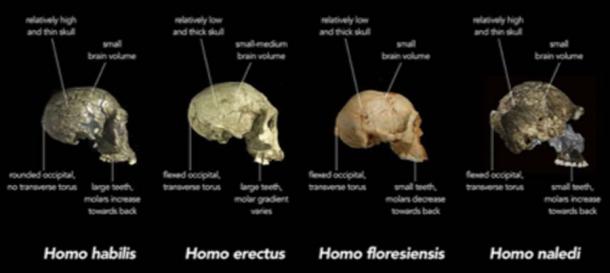
Early human species from the Stone Age. (Animalparty / CC BY-SA 4.0)
The Palaeolithic is generally divided into the Lower Palaeolithic, lasting from about 2.5 million years ago to about 200,000 BC, the Middle Palaeolithic, lasting from 200,000 BC to about 40,000 BC, and the Upper Palaeolithic, starting about 40,000 BC and lasting until 10,000 BC.
The Lower Palaeolithic
The Lower Palaeolithic begins with appearance of the earliest human species, that is, the first species that can be identified as a member of the genus Homo. Characteristics of genus Homo include an upright bipedal posture and a large brain. The earliest member of our genus is Homo habilis.
H. habilis still had ape-like body proportions with long arms compared to their legs, but their brains were larger than the australopithecines and other bipedal apes that preceded them. They were also responsible for making some of the first stone tools, though archaeologists now know that stone tools pre-date the appearance of H. habilis.
The earliest stone tools were made by taking a cobble, or hammerstone, and striking it against a larger rock, or core, to get sharp flakes that could be used as cutting tools. These early tools are primitive, but they represent the earliest recognizable tools used by humans. These sharp flakes were most likely used to help cut meat from bone.
These stone tools, dating to the earliest part of the Lower Palaeolithic, are referred to as the Oldowan toolkit. H. habilis probably never left Africa and their ape-like body proportions suggest that they still spent at least some of their lives in trees.
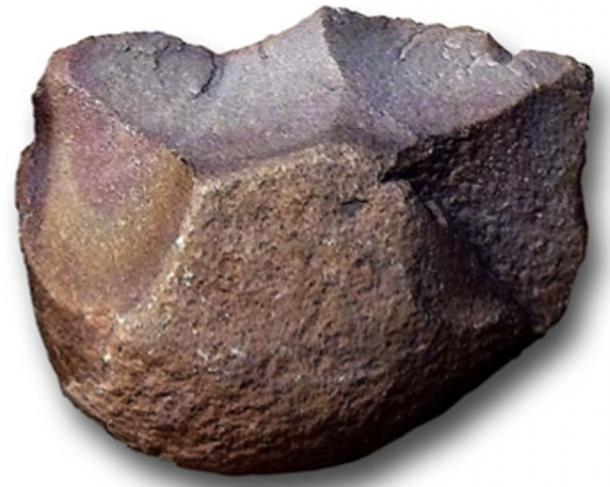
Stone Age Oldowan stone tool from the western Sahara. (Locutus Borg / Public Domain)
Around 2 million years ago, a new human species appeared which is referred to as Homo ergaster. H. ergaster was the first human species to have an anatomically modern body design with legs significantly longer than the arms. Skeletal remains suggest that they were also very tall, as much as 6 feet (1.8 meters).
At the same time that H. ergaster appears in the fossil record, more advanced stone tools appear in the archaeological record. These tools are flake tools that have been modified by removing smaller flakes from them to create a more specialized shape. One example of these next generation stone tools is the ‘hand axe’.
These tools represent what archaeologists call the Achuelian tool-making tradition. The purpose of these new tools is uncertain, but archaeologists believe that they were most likely for processing meat. The making of these tools requires more precision and planning and reflects an increase in the cognitive abilities of the toolmakers.
H. ergaster was the first human species to expand out of Africa, eventually settling Europe and East Asia. Asian examples of the species are called Homo erectus, while H. ergaster is reserved for African examples of the species. Some anthropologists consider H. erectus and H. ergaster to be separate species while others consider them to be Asian and African varieties of the same species.
H. erectus also may have been the first human species to intentionally use fire. Furthermore, it is likely that they were the first humans to rely on material culture as a primary means of adaptation to their environment.
- Greek Art Goes Palaeolithic: Cretan Cave Art Includes an Animal Extinct for 11,000 Years
- Stone Age Dead Were Put on Display Before Being Buried in the Homes of the Living
- New study finds ancient humans butchered elephants with stone tools 500,000 years ago
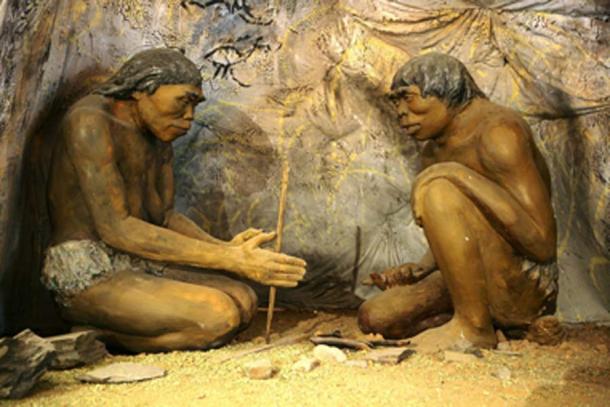
A diorama showing H. erectus, the earliest human species that is known to have controlled fire. (High Contrast / Public Domain)
One important fact that makes humans cultural animals is that we use tools as a primary way to interact with our environment. Chimpanzees will use tools occasionally, but they are able to get by in hunting and other activities without tools.
Humans, on the other hand, usually use tools when hunting, gathering food, or performing almost any activity. It is debatable whether a human could even survive long without any tools. Using culture as a primary approach to adaptation in humans appears to have begun with H. erectus/H. ergaster.
The Acheulian toolkit appears to have been the dominant cultural tradition in Eurasia and Africa from 1.9 million years ago until about 200,000 years ago, when evolutionary advances in cognition turned the tide and began the next phase of the Palaeolithic.
The Middle Palaeolithic
Around 400,000 years ago, early humans began developing the ‘prepared-core technique’, a technique in which tools could be made by splitting off flakes of a pre-determined size and shape. This control over the end-result of the process allowed for diversification and standardization of the sorts of tools that could be made.
This development probably represents another advance in cognition because such an elaborate stone-tool making technique requires even greater skill and deliberation than previous tool-making traditions. Hafted tools, tools that are placed on wooden handles, also first appear during this period. It is also during the Middle Palaeolithic that the first spears with stone spearpoints were probably made.
Coinciding with this advance in tool use is the rise of a new human species, or at least a potential human species, sometimes referred to as Homo heidelbergensis. H. heidelbergensis first began to evolve in Africa about 800,000 years ago and eventually spread from Africa to Eurasia.
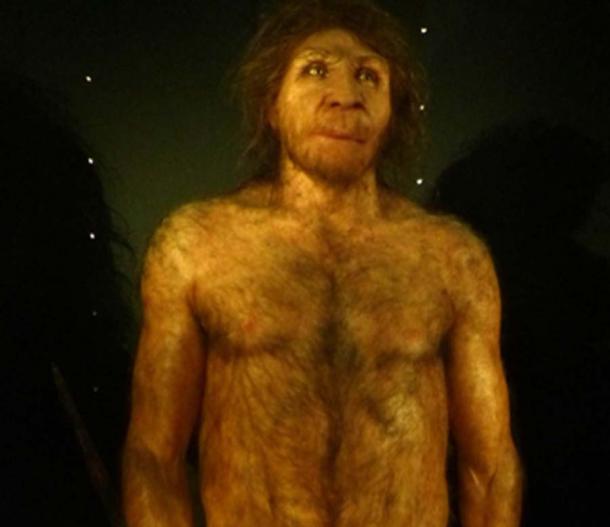
Stone Age H. heidelbergensis adult male reconstruction. (Dbachmann / CC BY-SA 4.0)
It is debated among anthropologists as to whether H. heidelbergensis counts as an actual separate species. Some believe that it should simply be referred to as archaic Homo sapiens, while others believe that there were actually two species, one in Africa and one in Eurasia.
Regardless of the exact taxonomic configuration, the humans of the Middle Palaeolithic appear to have had more advanced cognition than earlier humans, allowing for more advanced tools. There is evidence that they may have been the first to bury their dead and the first to have true spoken language. The rise of language would definitely have made it easier to develop complex tool traditions that could be taught and passed down from generation to generation.
It is also probably during the Middle Palaeolithic that humans went from being scavengers to being big game hunters. The tools used by earlier human species, such as H. erectus, suggest that the earliest humans scavenged meat from the carcasses left by carnivores. In fact, this may be how the first humans left Africa, following carnivores, such as saber-toothed cats, as they scavenged the carnivore’s unfinished kills.
The weapons of the Middle Palaeolithic, such as spears, and the average size of animal specimens found at butchering sites suggest actual hunting, possibly indicating that big game hunting began during the Middle Palaeolithic.
As time went on, and human populations became more separated, the early humans of the Middle Palaeolithic appear to have separated into three distinct species, Neanderthals in Europe, H. sapiens in Africa, and the Denisovans in Asia. These distinct species probably evolved around 200,000 to 300,000 years ago.
Neanderthals and H. sapiens both had advanced tools compared to earlier humans and both appear to have had language. Although H. sapiens would later develop evidence of slightly more advanced cognitive abilities than Neanderthals, for most of the Middle Palaeolithic, they appear to show about the same cognitive abilities as other contemporary human species.
The Upper Palaeolithic
The Upper Palaeolithic is characterized by more advanced tools made of more diverse materials. These tools include stone blades, which were more elongated and more finely crafted then earlier tools.
The Upper Palaeolithic is marked by the emergence of most of the aspects of culture generally considered unique to H. sapiens, such as art and religion. Although there is emerging evidence that Neanderthals also produced art, most artwork and figurines are still associated with H. sapiens.
- Archaeologists in Spain Unearth Rare Paleolithic Art Featuring Bird and Human Interaction
- Old tools found in China go back earlier in time than previously believed
- Skull Cups and Chewed Bones: Cannibalism was Ritual Behavior during Stone Age say Researchers

The Cave of Altamira earliest paintings were applied during the Stone Age - Upper Paleolithic. (Magnus Manske / CC BY-SA 2.0)
By 40,000 years ago, anatomically modern humans had entered Eurasia and displaced the Neanderthals, Denisovans, and remnant populations of H. erectus that still lived in Island Southeast Asia. This displacement appears to have been a gradual process, however, and there is evidence of H. sapiens co-existing and even interbreeding with other human species for long periods of time.
It is also during the Upper Palaeolithic that humans arrived in Australia and the Americas for the first time in prehistory. H. sapiens were the first and only known human species to colonize these regions.
The Upper Palaeolithic is known for the widespread appearance and use of stone blades, harpoons, and artwork for the first time in human prehistory. Traditionally, these examples of technology and artwork have all been attributed to the rise and spread of H. sapiens, but recent archaeological evidence suggests that the same cognitive revolution may have also been happening in Neanderthals.
Currently there is no way of knowing whether the Denisovans had a similar cognitive revolution, since they have no archaeological record. Nonetheless, they were related closely enough to modern humans that the two populations were able to interbreed which makes it likely that the Denisovans were similarly advanced in terms of cognition.
Neolithic – The New Stone Age
The term Neolithic means ‘New Stone Age’. The Neolithic is typically considered to have begun about 12,000 years ago. Around this time, the earliest farming communities began to emerge, initially in the ancient Near East and then elsewhere independently.
By about 9,000 BC, agricultural settlements had emerged all over Southwestern Asia and elsewhere. Farming eventually resulted in a food surplus so that not everyone needed to farm or gather food fulltime. This allowed for craft specialization and a division of labor for the first time in human history.
The Stone Age – Beginning of Early Human Societies
The rise of agriculture allowed for the rise of large settlements and very large populations. These populations led to social structures which had not yet existed, including chiefdoms and states.
It is during the Neolithic that human societies began to resemble the societies of social insets more than earlier primate societies. Earlier human societies consisted of no more than a few hundred individuals living in family groups.
These new human societies consisted of thousands to tens of thousands of individuals and seemed to act as organisms in of themselves, needing to expand through trade and warfare. By the end of the Neolithic, the human race had changed in such a way that it would never again be the same.
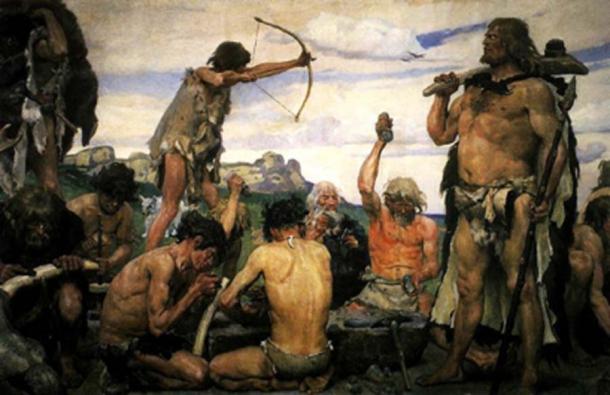
The Stone Age brought about early human societies. (Gugatchitchinadze / CC BY-SA 4.0)
Top image: Stone Age early human child. Source: pxhere / Public Domain.
By Caleb Strom
References
Alex, B. 2016. Meet the Denisovans. Discover Magazine. [Online] Available at: http://discovermagazine.com/2016/dec/meet-the-denisovans
Editors of Encyclopaedia Britannica. 2019. Paleolithic Period. Encyclopaedia Britannica. [Online] Available at: https://www.britannica.com/event/Paleolithic-Period
Essential Humanities. Date Unknown. The Stone, Bronze, and Iron Ages. Essential Humanities. [Online] Available at: http://www.essential-humanities.net/history-overview/stone-bronze-iron-ages/#bronze-and-iron-ages
Gill, N. 2018. The Bronze Age. ThoughtCo. [Online] Available at: https://www.thoughtco.com/bronze-age-117138
Hendry, L. 2018. Homo erectus, our ancient ancestor. Natural History Museum. [Online] Available at: https://www.nhm.ac.uk/discover/homo-erectus-our-ancient-ancestor.html
Hirst, K. 2019. Three Age System - Categorizing European Prehistory. ThoughtCo. [Online] Available at: https://www.thoughtco.com/three-age-system-categorizing-european-prehistory-173006
Hirst, K. 2018. Upper Paleolithic - Modern Humans Take the World. ThoughtCo. [Online] Available at: https://www.thoughtco.com/upper-paleolithic-modern-humans-173073
Marris, E. 2018. Neanderthal artists made oldest-known cave paintings. Nature. [Online] Available at: https://www.nature.com/articles/d41586-018-02357-8
New World Encyclopedia. 2008. Homo heidelbergensis. New World Encyclopedia. [Online] Available at: https://www.newworldencyclopedia.org/entry/Homo_heidelbergensis
Smithsonian. Date Unknown. Early Stone Age Tools. Smithsonian National Museum of Natural History. [Online] Available at: http://humanorigins.si.edu/evidence/behavior/stone-tools/early-stone-age-tools
Smithsonian. Date Unknown. Homo habilis. Smithsonian National Natural History Museum. [Online] Available at: http://humanorigins.si.edu/evidence/human-fossils/species/homo-habilis
Smithsonian. Date Unknown. Later Stone Age Tools. Smithsonian National Museum of Natural History. [Online] Available at: http://humanorigins.si.edu/evidence/behavior/stone-tools/later-stone-age-tools
Smithsonian. Date Unknown. Middle Stone Age Tools. Smithsonian National Museum of Natural History. [Online] Available at: http://humanorigins.si.edu/evidence/behavior/stone-tools/middle-stone-age-tools
Whipps, H. 2008. How the Iron Age Changed the World. Live Science. [Online] Available at: https://www.livescience.com/2339-iron-age-changed-world.html















